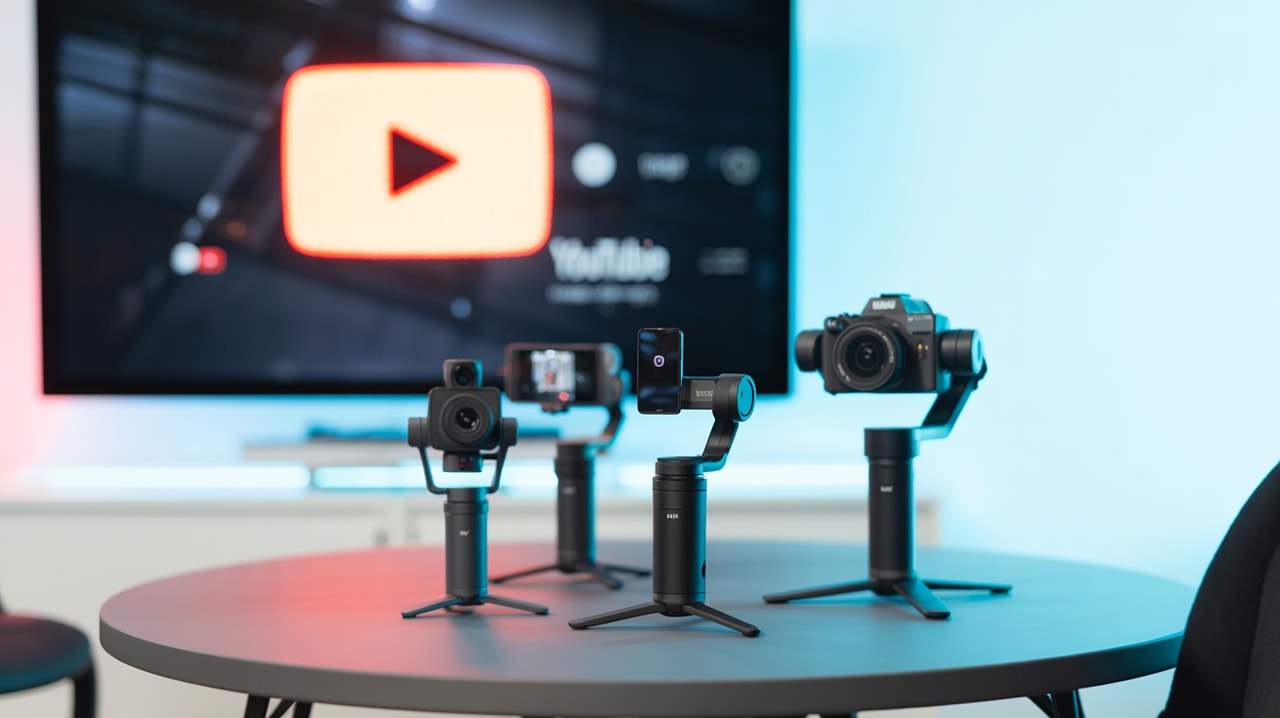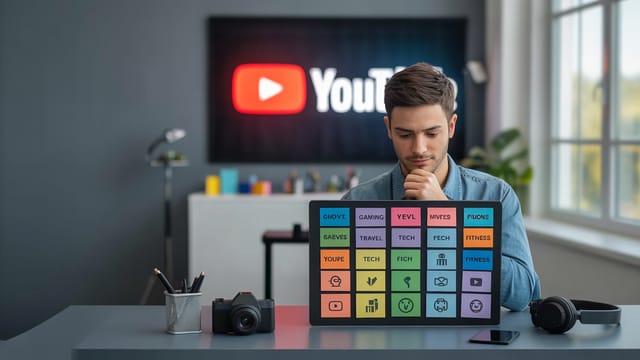
Ready to get your next 10,000 subscribers?
Join thousands of creators who use Subscribr to create faster, better YouTube videos.
Best Gimbal Stabilizers for Smooth YouTube Footage (All Budgets)
Shaky video is one of the quickest ways to lose viewers on YouTube. No matter how compelling your content is, if your footage is jarring and unstable, people will click away. This is a major pain point for many creators, especially vloggers and those who shoot on the go. While in-camera stabilization has improved, it often doesn't provide the buttery smooth, professional look that a dedicated gimbal stabilizer can.
Investing in a gimbal might seem like a technical hurdle with a steep learning curve, and the cost can feel prohibitive, especially for creators on a budget. However, the good news is that there are excellent gimbal options available today for every type of camera – from your smartphone to a professional DSLR or mirrorless setup – and at various price points.
A gimbal is a motorized mount that uses sensors and motors to keep your camera level and stable, even when you're moving. Unlike older, non-motorized stabilizers that rely on counterweights, modern gimbals actively counteract your movements, resulting in incredibly smooth footage. This is particularly crucial for specialized filming setups like vlogging, where you're often walking and talking to the camera.
Do I Need a Gimbal for YouTube Vlogging?
If you're serious about vlogging or any type of content that involves movement, a gimbal is a game-changer. While some smartphones and cameras have decent built-in stabilization, a gimbal takes it to the next level. Handheld footage, even with careful steps, will inevitably have some shake. A gimbal eliminates this, allowing you to create professional-looking tracking shots, pans, and tilts that are impossible otherwise.
Think about the "Travel Vlogger's Dilemma" – trying to capture the energy of a new place while walking through crowded streets or across uneven terrain. Without a gimbal, that footage would be nearly unusable due to shake. A gimbal transforms that shaky mess into smooth, watchable content that keeps viewers engaged.
How Much Does a Good Gimbal Cost?
The cost of a gimbal varies significantly depending on the type of camera you'll be using it with.
- Smartphone Gimbals: These are the most affordable options, typically ranging from $100 to $300. They are lightweight, portable, and designed specifically for the weight and size of smartphones. Many offer features like object tracking and motion time-lapses.
- Mirrorless and DSLR Gimbals: These gimbals are more robust and designed to handle the heavier weight of larger cameras and lenses. They can range from $300 to over $1000, depending on the payload capacity and features.
When choosing a gimbal, it's crucial to consider the weight of your camera and your heaviest lens, as the gimbal needs to be able to support that payload for optimal performance. Don't just look at the camera body weight; factor in the lens and any accessories like microphones or external monitors.
Gimbal vs Camera Stabilization for YouTube?
While in-camera stabilization (either sensor-shift or digital) is a valuable feature and can reduce minor shakes, it cannot replicate the smooth, cinematic motion achieved with a three-axis motorized gimbal.
Camera stabilization works by shifting the sensor or digitally cropping and adjusting the image to compensate for movement. This is effective for small jitters or slight handshakes. However, when you're walking, running, or making larger camera movements, in-camera stabilization can only do so much. It often results in an unnatural, "jello" effect or simply isn't enough to keep the footage truly smooth.
A gimbal, on the other hand, uses brushless motors to physically keep the camera level on three axes (pan, tilt, and roll). This allows for fluid, controlled camera movements that are essential for professional-looking video. For serious videography, especially dynamic shots or vlogging while moving, a dedicated gimbal is an essential investment that goes far beyond what in-camera stabilization can offer.
Choosing the Right Gimbal for Your YouTube Channel
Selecting the best gimbal depends on your camera setup, budget, and the type of content you create.
Smartphone Gimbals
For creators primarily shooting with their smartphones, a smartphone gimbal is the most practical and affordable choice. These gimbals are designed for portability and ease of use.
Many modern smartphone gimbals offer quick setup, intuitive controls, and intelligent features like subject tracking, which can be incredibly useful for solo creators or vloggers. When choosing, consider the maximum payload to ensure it can handle your phone, especially if you use additional lenses or accessories.
Budget-friendly options in 2025 provide a good mix of quality and features for their price, making professional-looking smartphone video more accessible than ever.
Camera Gimbals (Mirrorless & DSLR)
If you're shooting with a mirrorless camera or a DSLR, you'll need a more powerful gimbal designed to support the increased weight. These gimbals offer greater stability and control for larger camera setups.
When selecting a camera gimbal, payload capacity is paramount. Check the gimbal's specifications to ensure it can comfortably support the combined weight of your camera body, lens, and any other mounted accessories. Overloading a gimbal will result in poor performance and could potentially damage the motors.
Look for features like quick-release plates for easy mounting and dismounting, and consider the gimbal's overall size and weight if portability is important for your workflow, such as for travel vlogging.
Enhancing Production Quality with a Gimbal
Beyond just stabilization, gimbals open up a world of creative possibilities for your YouTube videos, significantly enhancing your production quality. You can achieve cinematic camera movements like smooth tracking shots where the camera follows a subject, or dramatic reveal shots with controlled pans and tilts.
Using a gimbal elevates the perceived production value of your content, making it look more professional and polished. This can help with audience retention, as viewers are more likely to continue watching high-quality, visually appealing videos.
However, it's also important to diversify your camera movements. While gimbals are fantastic, relying solely on gimbal shots can make your videos feel monotonous. As expert YouTube strategists suggest, mix gimbal shots with handheld footage for energy and immediacy, and tripod shots for static stability. Tools like Subscribr's Video Breakdown Tool can help you analyze the camera movement techniques used in successful videos in your niche, giving you ideas for diversifying your own shots.
Gimbals and the Vlogging Workflow
For vloggers, a gimbal is almost a necessity, especially if you're shooting while walking, moving through dynamic environments, or want to capture smooth follow-me style footage. The ability to move freely while maintaining stable footage is invaluable for creating engaging vlogs.
Many gimbals designed for vlogging are lightweight and compact, making them easy to carry around all day. Some even have built-in extension rods, perfect for getting wider shots or filming yourself at a comfortable distance.
Mastering a gimbal for vlogging does have a slight learning curve, primarily in balancing your camera correctly and learning how to move smoothly yourself. However, with a little practice, you'll be able to capture incredibly stable and dynamic footage that will make your vlogs stand out.
Monetization Angle: Solving a Problem and Driving Affiliate Sales
For creators who review tech or filming equipment, an article like this presents a clear monetization opportunity through affiliate marketing. By recommending specific gimbals and linking to them using affiliate links, you can earn a commission on sales.
More broadly, for any creator, a gimbal helps solve a fundamental problem: shaky, unprofessional-looking video. By investing in a gimbal, creators are investing in their channel's quality and their ability to attract and retain viewers. This improved production value can lead to increased watch time, more subscribers, and ultimately, better monetization through AdSense, sponsorships, or other revenue streams. For vloggers, particularly travel vloggers, a gimbal is a key tool that directly enables their content style, making it a natural product to recommend and use for affiliate marketing.
Getting Started with Your Gimbal
Once you have your gimbal, take some time to practice balancing your camera and experimenting with different movements. Most gimbals come with tutorials or apps that can guide you through the initial setup and calibration.
Remember that a gimbal is a tool to enhance your storytelling. While smooth footage is important, it's just one piece of the puzzle. Focus on creating compelling content, engaging with your audience, and using tools like Subscribr's AI Script Writer and Research Assistant to refine your video ideas and scripts. Subscribr's Channel Intelligence system can also help you analyze your video performance, including how factors like production quality impact metrics, enabling you to continuously improve.
By addressing the pain points of shaky video, technical complexity, and budget constraints, and by providing clear, actionable advice on selecting and using gimbals, you can create YouTube content that is not only visually appealing but also highly valuable to your audience, ultimately contributing to your channel's growth and success.





